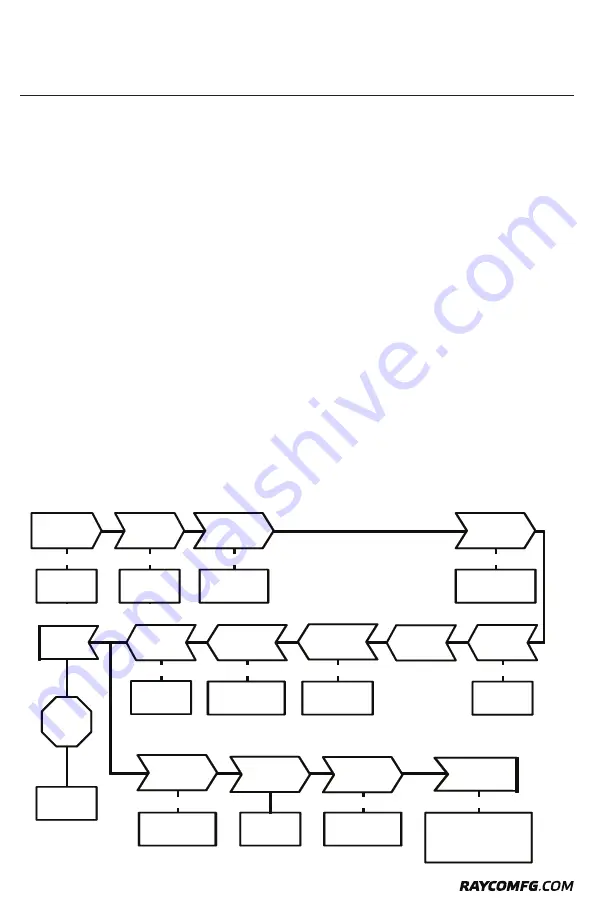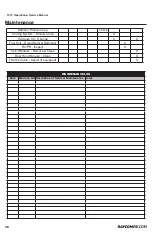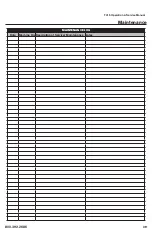
T415 Operation & Service Manual
52
Maintenance
CHECK
ALL
FITTINGS
FILL
RESERVOIR
SUPPLY 10 PSI
MAXIMUM
COMPRESSED
AIR
LOOSEN CASE
DRAIN OUTLET
AT MOTOR
BE
TIGHT
PROPER
FILTERED
FLUID
SEALED
RESERVOIR
MUST
IF
NOT
STOP
AND
TROUBLE
SHOOT
WITH
TO
FLUID TO FILL
BOTH PUMP AND
MOTOR CASES
ALLOW
CHARGE
PRESSURE
OR
RUN
PRIME
MOVER
CONTROL
IN
NEUTRAL
WHEN
FLUID
AT LEAST
200 TO
220 PSI
CHARGE PRESSURE
GAUGE
STARTS CLIMBING
40 SECONDS
AT
LOW SPEED
TIGHTEN CASE
DRAIN OUTLET
AT MOTOR
IS
UNTIL
FOR
APPEARS
SET
PRIMER
MOVER
CYCLE PUMP
CONTROL
SLOWLY
CHARGE
PRESSURE
STOP
PRIMER
MOVER
50% OF
MAXIMUM
THROTTLE
2 OR 3
TIMES
DROP APPROX.
40 PSI
IN CHARGE
REMOVE GAUGE
REPLACE PLUG
CHECK FLUID LEVEL
SYSTEM READY TO
OPERATE
AT
SHOULD
THEN
1
2
3
4
5
6
7
8
9
10
11
12
13
14
and motor cases to fill with fluid for instant lubrication
at start-up.
5. Fill Pump and Motor Cases of the circuit through the
uppermost case drain ports. This gives both units
instant lubrication at start-up. Also remove top hose
connection of the HC (Hydraulic Cylinders) pump, fill
with oil, and reinstall top hose connection. This will
provide instant lubrication to HC pump at start-up.
6. Placing the pump Control in Neutral at start-up
is essential to prevent any unexpected machine
movement.
7. Run the Prime Mover (engine) for a short period
of time using the starter. (Crank the engine briefly,
repeatedly.) This allows the charge pump to start
filling the system. Start the engine and run at lowest
speed. Shut the engine down within 40 seconds if
the charge pressure does not increase steadily to
approximately 340 to 440 Psi.
8. Or run the prime mover until the charge pressure
gauge starts climbing steadily, showing the system is
filling. If the charge pressure gauge does not move,
stop the prime mover and recheck installation.
9. Charge Pressure should be steady at approximately
340 to 440 Psi. This indicates the system is full.
10. If Not at this pressure, stop the prime mover and
troubleshoot the installation and system.
11. Set the Prime Mover at approximately 50 percent of
maximum throttle for a few minutes. This will purge
any remaining trapped air from the system.
12. Cycle Track Control Slowly. Restart the prime mover,
and actuate the track control two or three times to
purge any trapped air from the system.
13. Stop the Prime Mover and remove pressure gauge
used at start-up. Replace the plug. Recheck the
reservoir fluid level and add fluid if necessary. Replace
the reservoir cap.
The hydrostatic circuit is now ready for operation.
Hydraulic Circuit
After the hydrostatic circuit is ready, the hydraulic circuit
may be prepared.
1. Check the reservoir level, and add more clean fluid if
necessary. Fill all other components in the HC circuit
with hydraulic oil as completely as possible.
2. Start the engine and run it at normal operating speed.
Using the boom motion controls, slowly, then at
normal operating speed, cycle the boom through all
its motions until all air is bled off. The motions will be
smooth and powerful when all of the air is bled off.
3. Check the reservoir level, and add more clean fluid if
necessary.
4. Remove the reservoir fill neck, and inspect strainer,
cap, and gaskets. Replace if damaged or worn. Clean
the strainer in clean, non flam ma ble solvent, and dry.
Install the strainer. Put a light coat of fuel oil on the fill
neck gasket. Install the fill neck. Inspect the gasket on
the breather cap, and replace if damaged. Install the
breather cap.
5. Clean up any spilled hydraulic fluid.











































